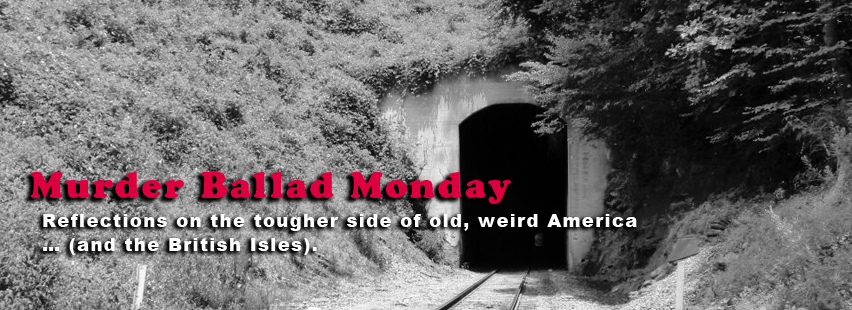“The Little Girl and the Dreadful Snake” – Conversations with Death – 6
<<<Back to page 1
Monroe and his band cut their own version of his original and released it as the B-Side of Decca 28878 in 1953. Interestingly, the A-Side was “Memories of Mother and Dad” – Bill’s mother died when he was ten and his father when he was sixteen. Though Bill wrote the song when he was older, one senses a universal vulnerability in it – the orphan singing is not a child, but not quite mature. It could have been a daughter too, as Hazel and Alice showed us in back in 1973. Though not exactly an uplifting combination, no one can deny its power and humanity. To put a finer point on it, the connection between the two songs is important to realize in considering below whence “Dreadful Snake” comes.
“The Little Girl and the Dreadful Snake” continues to be a standard bluegrass cover, and is even represented by acts outside the genre. On a personal level, I find none of them as compelling as the trio I’ve linked above, but you can judge for yourself with my playlist. Because it was the first version I ever heard, I’ll expect I’ll always remain partial to the Ramblers’ cut – however, the real power behind the song comes from Monroe’s lyrics. There’s just no getting around that. So, just what are that girl and the snake telling us that compels us to listen?
“The snake was warning me close by…”
Teresa Goddu, in her 1995 essay “Bloody Daggers and Lonesome Graveyards: The Gothic and Country Music,” cites Monroe’s “The Little Girl and the Dreadful Snake” as an example of “fear of and extreme response to female sexuality.” She compares it with “Katie Dear” as a song in which a young woman is “approaching sexual maturity” and reads the conclusion of the action and the warning from the father as dire. “Once again, female sexuality is life-threatening: the little girl must die; her impurity must be punished… a woman who becomes sexual cannot stay alive.”
 In this blog we’ve never shied away from dealing with misogyny in our genre of choice. Professor Goddu has an unalienable right to hear a song in any way she chooses, regardless of what even the writer thinks about it. However, without meaning to erase the broader strokes of Goddu’s insightful essay, I think when it comes to this song she’s seeing a pit of vipers instead of a lone rattler hiding in the leaves. No one can speak with certainty about the mystery of another’s psyche, yet understanding the true story of the song’s creation does indeed require a dive into the murky depths of Monroe’s insecurities. Richard D. Smith did so, and in his comprehensive biography, Can’t You Hear Me Calling: The Life of Bill Monroe, The Father of Bluegrass, he makes plain that the fear which compelled Monroe to write this song and several similar ones is pre-pubescent.
In this blog we’ve never shied away from dealing with misogyny in our genre of choice. Professor Goddu has an unalienable right to hear a song in any way she chooses, regardless of what even the writer thinks about it. However, without meaning to erase the broader strokes of Goddu’s insightful essay, I think when it comes to this song she’s seeing a pit of vipers instead of a lone rattler hiding in the leaves. No one can speak with certainty about the mystery of another’s psyche, yet understanding the true story of the song’s creation does indeed require a dive into the murky depths of Monroe’s insecurities. Richard D. Smith did so, and in his comprehensive biography, Can’t You Hear Me Calling: The Life of Bill Monroe, The Father of Bluegrass, he makes plain that the fear which compelled Monroe to write this song and several similar ones is pre-pubescent.
[Bill,] the youngest of the eight children of James Buchanan Monroe and Malissa Vandiver Monroe, was born with a left eye that turned inward. The medical term for the condition is esotropia. In this time and place, the brutal slang expression was “hug-eyed.”
His overall vision was very poor. In compensation, his auditory sense developed keenly. He learned to recognize from miles away the hoofbeats of horses and mules and the roll of wooden wheels. Experience taught that passersby were coming who would laugh and joke about this cross-eyed boy if they saw him. So he would run and hide in the barn until they passed.
As the youngest of a large family, he was often left alone by his busy parents and impatient siblings. He grew thoughtful, his feelings sensitive, his emotions powerful but unexpressed, yearning for human contact but too proud to admit pain.
He once looked back on his childhood and said:
“For many years, I had nobody to play with or nobody to work under. You just had to kindly grow up. Just like a little dog outside, tryin’ to make his own way, trying to make out the best way he can.”
Bill Monroe was in some ways an abandoned child; perhaps not literally, but if we take him at his word then we can’t ignore his childhood sense of being a ‘lost puppy’ in a world that was at best indifferent to him and at worst hostile and degrading. There were precious few to protect him from such threats. This alone doesn’t prove anything about the song, of course. However, Smith was able to access a wide variety of information in piecing together Monroe’s past, including several interviews with Bill’s beloved niece Rosetta Monroe Kiper, daughter of his brother Speed. It’s in these interviews that Smith uncovered the inspiration for “The Little Girl and the Dreadful Snake.”


